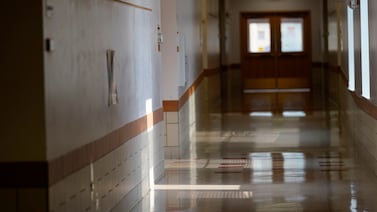Sign up for Chalkbeat Detroit’s free daily newsletter to keep up with the city’s public school system and Michigan education policy
Michigan lawmakers are poised to approve a state education budget that would build on last year’s historic investment in the state’s most vulnerable students, while also increasing funding to improve student mental health, education for English language learners, and literacy.
But some students, parents, educators, and advocates are worried that the state won’t be able to fully fund “dire” needs at a time when Michigan faces several budgetary challenges.
Roughly $5.6 billion in federal COVID relief funds will expire this year, and state revenue growth is expected to slow in coming years. Declining enrollment also has created funding shortfalls in some districts.
Some fear districts will face painful cuts.
“The state of education right now is – truly, we’re desperate,” said Kathi Martin, a speech language pathologist and union president in Dearborn Public Schools.
“The amount of resources we have never seems to be enough,” she added.
Last week, the House passed a proposed budget that would increase school funding by $900 million compared to last year’s. That’s just slightly higher than what Whitmer proposed in her executive budget.
The Senate appropriations committee has also proposed an increase in school aid, of $1.1 billion. The Senate has not yet voted on the committee’s recommended budget, however, and is expected to take a vote in the coming days.
The legislature has a deadline of July 1 to pass a state budget. When both houses pass a budget, it will go to the governor to sign. It will take effect Oct. 1.
Last year, lawmakers passed a $21.5 billion school budget that included historic increases to benefit the state’s neediest students. But advocates say legislators must keep up the momentum to continue to work toward more equitably funding Michigan schools.
Here’s what lawmakers have proposed:
Increases to the “opportunity index”
For years, Michigan has been ranked among the worst states in the nation for the inequities in funding between schools in wealthy and poor communities.
Last year, the budget gave an additional $1 billion in funding to districts to serve at-risk students through the “opportunity index,” which provides money to districts serving communities with higher concentrations of poverty.
“Michigan must continue to take bold steps for an equitable education for its students,” said Elnora Gavin, a Benton Harbor School Board member, in a statement.
Here are some of the highlights:
- The Senate committee’s proposal includes a $122.6 million increase to at-risk funds. It would allow districts to use up to 60% of the money to recruit and retain instructional staff as well as staff who help improve students’ social, emotional, or physical health.
- The House proposes a $70.1 million increase. That proposal also includes language that would allow the Detroit Public Schools Community District to use up to 40% of the money to hire more instructional staff or increase teacher salaries.
- The executive proposal would increase at-risk funding by $23.8 million. It would allow some districts to use up to 30% of the money for teacher recruitment and retention.
Advocates have asked lawmakers to increase the opportunity index funds by 20% over the next five years until it eventually equates to around $2.9 billion in additional funding for at-risk students each year.
What legislators are currently recommending for 2024-25 ranges from a 2.5% to around 12.8% increase over last year’s at-risk funding.
More money for mental health
Since 2021, Michigan has invested more than $715 million in student mental health programs and hiring more school counselors. However, advocates and educators say more school counselors, psychologists, and social workers are needed to adequately address students’ needs during an ongoing youth mental health crisis. The state had the third highest ratio of counselors to students in the country, according to the most recently available data.
“A lot of students’ grades are low because they are facing mental health problems and are not being heard by our teachers,” said Christina Yarn, a 17-year-old attending Saginaw Community Schools’ Heritage High School.
The governor’s office and the House both propose $300 million in per-pupil funding – $3.3 million more than last year– to improve student mental health and school safety, which is in line with what advocates have asked for. Both proposals have restrictions on the funds to be used for school resource officers. The Senate committee proposes a lower amount, $150 million for the funds, with no restrictions on districts for paying school police.
Small increase for English language learners
The state increased funding for English language learners last year, but still ranked among the worst in the nation for its funding of such programs compared to other states in 2023, according to Ed Trust Midwest.
“We have many immigrant and migrant students attending our schools,” said Martin. “Lots of children come to school and they don’t know English. In order to adequately teach these children, we need more resources than just one teacher in a room with 27 kids.”
The Senate committee’s proposal would double funding for English learners with an increase of $39.7 million.The governor and the House propose much smaller increases – $3 million and $5 million respectively.
One-time funds for literacy
Michigan has long struggled with student literacy rates. It ranks 43rd in the country for fourth grade reading. While more money was allocated to literacy efforts such as reading coaches and early literacy training for teachers last year, some administrators say they are unable to fill open positions.
The governor proposed $155 million in one-time funding to create a Committee for Literacy Development; offer a ranked list of curricula and professional development for teachers; and fund early literacy teacher coaching positions. The House and the Senate committee’s proposals include similar budget items.
Cuts to the teacher retirement fund
In order to pay for proposed increases to big items on the proposed budgets, legislators are considering making cuts to contributions to the state’s retirement funds for public school employees.
The governor wants to fund $758.9 million less than the $2.5 billion the state put into the Michigan Public School Employees’ Retirement System in 2023-24. The House proposes reducing payments to the funds by $562.4 million. The Senate committee recommends $41.3 million in cuts.
Republican lawmakers have voiced concerns that these cuts would add to an existing pension debt in the system.
Democrats, including Whitmer, say that health care is fully funded under the plan and that it is feasible for the state to scale back its investments in helping districts make payments into the plan.
Hannah Dellinger covers K-12 education and state education policy for Chalkbeat Detroit. You can reach her at hdellinger@chalkbeat.org.





